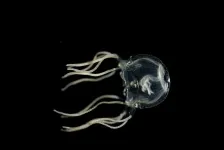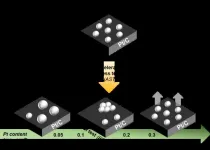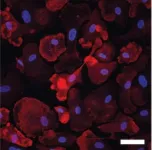(Press-News.org) Even without a central brain, jellyfish can learn from past experiences like humans, mice, and flies, scientists report for the first time on September 22 in the journal Current Biology. They trained Caribbean box jellyfish (Tripedalia cystophora) to learn to spot and dodge obstacles. The study challenges previous notions that advanced learning requires a centralized brain and sheds light on the evolutionary roots of learning and memory.
No bigger than a fingernail, these seemingly simple jellies have a complex visual system with 24 eyes embedded in their bell-like body. Living in mangrove swamps, the animal uses its vision to steer through murky waters and swerve around underwater tree roots to snare prey. Scientists demonstrated that the jellies could acquire the ability to avoid obstacles through associative learning, a process through which organisms form mental connections between sensory stimulations and behaviors.
“Learning is the pinnacle performance for nervous systems,” says first author Jan Bielecki of Kiel University, Germany. To successfully teach jellyfish a new trick, he says “it’s best to leverage its natural behaviors, something that makes sense to the animal, so it reaches its full potential.”
The team dressed a round tank with gray and white stripes to simulate the jellyfish’s natural habitat, with gray stripes mimicking mangrove roots that would appear distant. They observed the jellyfish in the tank for 7.5 minutes. Initially, the jelly swam close to these seemingly far stripes and bumped into them frequently. But by the end of the experiment, the jelly increased its average distance to the wall by about 50%, quadrupled the number of successful pivots to avoid collision and cut its contact with the wall by half. The findings suggest that jellyfish can learn from experience through visual and mechanical stimuli.
“If you want to understand complex structures, it’s always good to start as simple as you can,” says senior author Anders Garm of the University of Copenhagen, Denmark. “Looking at these relatively simple nervous systems in jellyfish, we have a much higher chance of understanding all the details and how it comes together to perform behaviors.”
The researchers then sought to identify the underlying process of jellyfish’s associative learning by isolating the animal’s visual sensory centers called rhopalia. Each of these structures houses six eyes and generates pacemaker signals that govern the jellyfish’s pulsing motion, which spikes in frequency when the animal swerves from obstacles.
The team showed the stationary rhopalium moving gray bars to mimic the animal’s approach to objects. The structure did not respond to light gray bars, interpreting them as distant. However, after the researchers trained the rhopalium with weak electric stimulation when the bars approach, it started generating obstacle-dodging signals in response to the light gray bars. These electric stimulations mimicked the mechanical stimuli of a collision. The findings further showed that combining visual and mechanical stimuli is required for associative learning in jellyfish and that the rhopalium serves as a learning center.
Next, the team plans to dive deeper into the cellular interactions of jellyfish nervous systems to tease apart memory formation. They also plan to further understand how the mechanical sensor in the bell works to paint a complete picture of the animal’s associative learning.
“It’s surprising how fast these animals learn; it’s about the same pace as advanced animals are doing,” says Garm. “Even the simplest nervous system seems to be able to do advanced learning, and this might turn out to be an extremely fundamental cellular mechanism invented at the dawn of the evolution nervous system.”
###
This work was supported by the Deutsche Forschungsgemeinschaft (DFG, German Research Foundation), the Danish Research Council (DFF), and the Villum Foundation.
Current Biology, Bielecki et al. “Associative learning in the box jellyfish Tripedalia cystophora” https://www.cell.com/current-biology/fulltext/S0960-9822(23)01136-3
Current Biology (@CurrentBiology), published by Cell Press, is a bimonthly journal that features papers across all areas of biology. Current Biology strives to foster communication across fields of biology, both by publishing important findings of general interest and through highly accessible front matter for non-specialists. Visit http://www.cell.com/current-biology. To receive Cell Press media alerts, contact press@cell.com.
END
Jellyfish are more advanced than once thought. A new study from the University of Copenhagen has demonstrated that Caribbean box jellyfish can learn at a much more complex level than ever imagined – despite only having one thousand nerve cells and no centralized brain. The finding changes our fundamental understanding of the brain and could enlighten us about our own mysterious brains.
After more than 500 million years on Earth, the immense evolutionary success of jellyfish is undeniable. Still, we've always thought of them as simple creatures with very limited learning abilities.
The prevailing opinion is that ...
About The Study: In this study using a behavioral experiment designed to mimic a real-world imposter scam among 644 older adults, a sizable number of older adults engaged without skepticism. The results suggest that many older adults, including those without cognitive impairment, are vulnerable to fraud and scams.
Authors: Lei Yu, Ph.D., of Rush University Medical Center in Chicago, is the corresponding author.
To access the embargoed study: Visit our For The Media website at this link https://media.jamanetwork.com/
(doi:10.1001/jamanetworkopen.2023.35319)
Editor’s ...
About The Study: The results of this study of 220,000 American Indian and Alaska Native patients with Medicare insurance suggest a significant burden of cardiovascular disease and cardiometabolic risk factors. These findings highlight the critical need for future efforts to prioritize the cardiovascular health of this population.
Authors: Lauren A. Eberly, M.D., M.P.H., of the Indian Health Service in Gallup, New Mexico, is the corresponding author.
To access the embargoed study: Visit ...
https://www.scienceopen.com/hosted-document?doi=10.15212/ZOONOSES-2023-0031
Announcing a new article publication for Zoonoses journal. Monkey B virus (BV) infection in humans and other macaque species has a mortality rate of approximately 80%. Because BV infects humans through bites, scratches, and other injuries inflicted by macaques, the simple and rapid diagnosis of BV in field laboratories is of great importance to protect veterinarians, laboratory researchers, and support personnels from the threat of infection.
Two recombinase polymerase amplification (RPA) assays with a closed vertical flow (VF) visualization strip (RPA-VF-UL27 and RPA-VF-US6) were developed that target ...
A research group at the University of Helsinki and its partners have found a promising drug candidate for the treatment of amyotrophic lateral sclerosis (ALS). Cerebral dopamine neurotrophic factor CDNF prolongs the lifespan of and alleviates disease symptoms in rats and mice in animal studies.
Amyotrophic lateral sclerosis (ALS) is a rapidly progressing fatal neurodegenerative disease that affects the nerve cells in the brain and spinal cord. Specifically, a selective degeneration of motoneurons occurs in the spinal cord, leading to muscle atrophy and paralysis. Most patients with ...
Researchers have made a significant finding in determining the genetic background of dilated cardiomyopathy in Dobermanns. This research helps us understand the genetic risk factors related to fatal diseases of the heart muscle and the mechanisms underlying the disease, and offers new tools for their prevention.
Researchers from the University of Helsinki and the Folkhälsan Research Center, together with their international partners, have identified the genetic background of dilated cardiomyopathy, a disease that enlarges the heart muscle, in dogs and humans.
Based ...
Proton exchange membrane fuel cells (PEMFCs) hold promise as a replacement for fossil fueled engines in heavy-duty vehicles. Reducing the platinum content in catalysts is pivotal for scaling up in such applications. Yet, the degradation patterns of low platinum content catalysts remain poorly understood. A team of scientists conducted experiments to shed light on the degradation mechanisms associated with varying catalyst content, offering valuable insights. Their work is published in the journal Industrial Chemistry & Materials on 11 Aug 2023.
In ...
Palm oil is the world's most produced and consumed vegetable oil and everyone knows that its production can damage the environment. But do consumers have the full picture? In fact, replacing palm oil with rapeseed oil would require a four to five-fold increase in the amount of land needed. Research led by the University of Göttingen investigated the attitudes, beliefs and understanding about palm oil of the general public in Germany, and how this links to land use. The researchers show that people find it hard to know the consequences of their buying choices, even when extra information is supplied. The results were published in Sustainable ...
CHAPEL HILL, N.C. – Scientists studying Alzheimer’s disease (AD) have identified thousands of genetic variants in the genome in the development of this progressive neurodegenerative disease.
These variants are predominantly located in genomic regions that do not code for proteins, making it difficult to understand which variants confer individuals’ risk of AD. Non-coding variants were once thought to be “junk DNA” by scientists. In recent years, these variants have been appreciated for playing crucial roles in controlling gene expression across tissues and cell types. However, linking these non-coding variants to the genes they regulate and effects ...
A groundbreaking study conducted by Jun Sun’s research team at the University of Illinois Chicago has revealed a new and critical role of Axin1 in regulating intestinal epithelial development and microbial homeostasis. The research, published in the journal Engineering, highlights the potential therapeutic strategies for human inflammatory bowel disease (IBD).
IBD, a chronic inflammatory disorder affecting the gastrointestinal tract, has been a significant health concern worldwide. The study focused on understanding the role of Axin1, a negative regulator of Wnt/β-catenin ...






